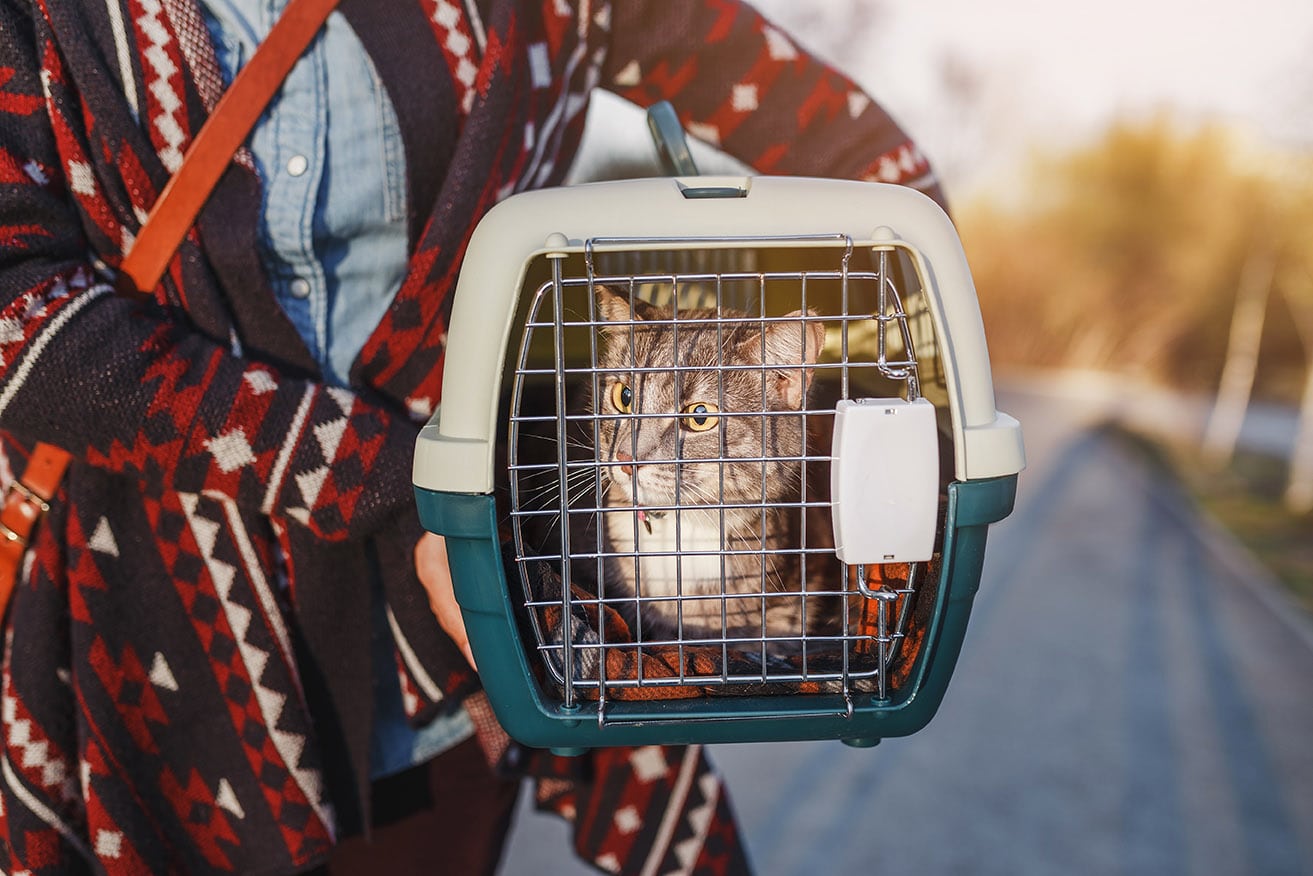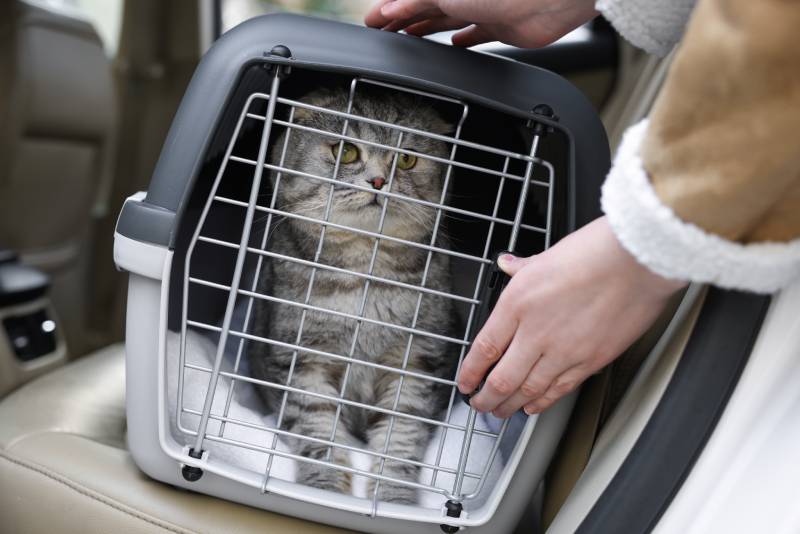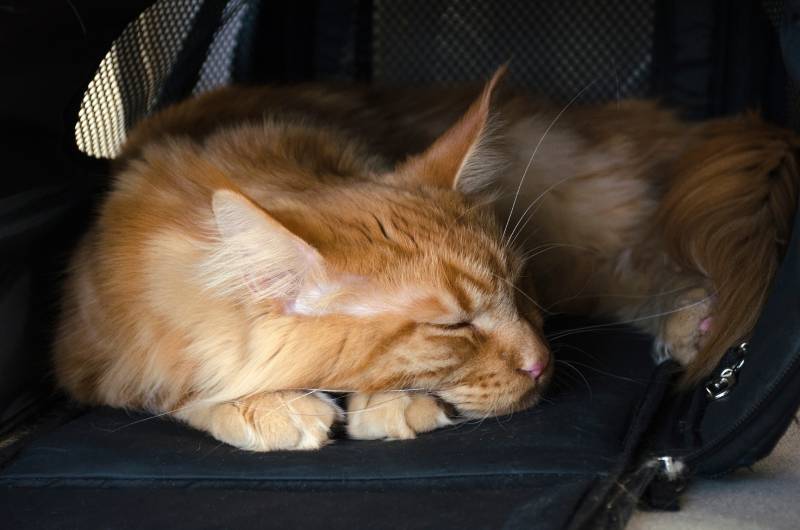
Whether your cat is going to the vet or on a trip across the country, finding the right cat carrier is essential. There are a number of considerations you will need to make—how big it is, what kind of material, and even how you close it up. Taking your cat on an airplane has specific rules that need to be followed as well.
We’ll discuss everything about cat carriers so you can make an informed decision that will work out for both you and your cat.
Escape Prevention
Above all, the single most important feature of a carrier should be the fact that it is escape-proof. If your cat can escape from a carrier, it isn’t serving its purpose. Cats are experts at escaping, especially when threatened.
Secure latches are the best way to prevent an escape. Though some carriers have zippers, a cat may potentially be able to undo a zipper with their claws. Therefore, zipper-based carriers should be padlocked for an added layer of protection.

How Big Should a Cat Carrier Be?
This is another crucial part of finding the right carrier for your cat. Particularly if your cat is going to be spending a long time in it, you certainly want them to be comfortable.
As a general rule, your cat should be able to lay down, stand, sit, and turn around inside their carrier. Essentially, it should be about one and a half times your cat’s size. It is important to keep in mind that there may be some unfortunate circumstances where your cat might be physically injured while being transported in the carrier. Though an injury is inherently uncomfortable, your cat will be better off in a carrier that they can comfortably lay down in should such a scenario ever occur.
It is perfectly acceptable to have multiple carriers for your cat. For example, you could opt for a backpack-style carrier for your cat’s outdoor excursions (provided that your cat is comfortable with the carrier and not scared of an outdoor trip). However, it’s important to have one that can comfortably fit your cat in a scenario where they are injured and cannot contort into a small carrier.

What if You’re Traveling a Long Distance?
If you’re planning on bringing your cat on a longer car drive than just across town to the vets, you’ll need to start looking at larger carriers. Be sure the cat carrier is large enough for your cat as well as water and food bowls.
If you’re actually driving across the country and expect to be on the road for days, you will want to consider a traveling carrier that can fit not only the food and water bowls but also a bed and small litter box. You can look into carriers that are meant for dogs.
What if You Have More Than One Cat?
This calls for one carrier for each cat, even if it’s a short trip to the vets. No matter how sweet your cats are with each other, when in a stressful situation and crammed together in a small space, they might turn on each other. Two carriers versus one large one is always your best bet.
At times, your veterinarian may apply topical medications to your cat. These medications are usually applied in an area where a cat cannot lick them. However, if your cat is in the presence of another cat, the other cat may easily lick off the medication. This makes it important to keep your cats in their own carriers during a vet visit.
What Kind of Material Should It Be?
There are several styles of cat carriers to choose from that also come in a variety of materials and colors.
Hard Plastic

Hard plastic is the most common type of cat carrier (also called kennels). It’s also the best. They’re very sturdy and tend to come in larger sizes so your cat can move around comfortably, and they typically have a removable top so you can clean them more easily. You should always consider this as your first choice for a cat, as they are by far the most reliable and safe option when it comes to transporting your cat to the veterinarian.
The rest of the carrier types below are acceptable for cats that don’t seem to mind them, but they are generally not recommended for veterinarian visits. They can be used for outdoor trips with your cat (provided your cat doesn’t mind them) but are not suitable for an injured cat that needs veterinary attention. They can be used to transport cats in emergencies when no other options are available.
Soft Material

Soft carriers tend to be made from durable materials such as nylon or polyester with mesh. They are not as sturdy or usually as large as the plastic carriers, and they are more difficult to clean if there are any accidents. It’s also a lot more challenging to get a struggling cat inside one, and zipping it closed on an escape artist can be difficult. As mentioned previously, a cat can undo a zipper with their claws; therefore, such carriers are not entirely escape-proof.
Soft material carriers are also convenient for storage, as they can easily be folded when not in use.
Backpacks

Just like regular backpacks, these are carriers that you can carry on your back, or if they come with wheels, you can extend a handle and roll it along the ground behind you. These tend to be somewhat similar to the soft carriers but have the added advantage of various options for carrying your cat around.
Such carriers are not without their drawbacks. One disadvantage of the wheeled backpacks is that many cats might not like the sound and bumpiness of the wheels on the pavement. They are also not easy to clean. As mentioned previously, an injured cat shouldn’t be placed in such a carrier, as they may feel extremely uncomfortable while contorted in such a carrier.
These carriers should not be your first choice, as not only do they expose your cat (leading to unnecessary stress), they also tend to have very poor circulation.
Cardboard

This is not a carrier that is considered a permanent one. You usually get one when you adopt a cat from a shelter or rescue group. They are easily soiled, and many cats can chew their way out of the cardboard, which can be dangerous while you’re driving. That, or they can push their way through the opening, which isn’t as secure as the others on this list. That being said, this is definitely an option when no other carrier is available.
What Are the Options for Closing the Carrier?
There are many different ways to close your carrier, but of course, it depends on what kind of carrier you’re interested in.
One Door
Some carriers tend to have just one door. Generally speaking, unless you know your cat’s personality well enough, these carriers are not advised. It is very difficult to get a reluctant cat in and out of such carriers.

Multiple Doors
These carriers are best, as there are multiple ways to lower your cat into a carrier. A carrier with access from the top/roof is also great as it may allow your vet the opportunity to easily scoop your cat out of the carrier.
Fastenings
Keeping in mind your cat’s behavior, you should think about how the carrier is fastened. Hard carriers tend to have latches, which are quite secure, and these carriers are pretty difficult for cats to escape from.
Soft carriers tend to have zippers, which are definitely more challenging to close if your cat is desperately trying to get out of the carrier you’ve just wrestled them into.

Seat Belt Loop
Some carriers come with the option of a seat belt loop so you can attach the carrier to your existing seat belts. Some of these carriers also include a tether inside that can be attached to your cat’s collar, but this option is more suitable for dogs and not cats.
Please note that a nervous cat may easily bolt out of their carrier if you open it to fasten a tether to their collar. Most feline collars are also break-away collars, and therefore, your cat may easily undo the tether as they bolt out. Cats should not be tethered to a seatbelt under any circumstances for their own safety.
Washable
Some soft carriers are machine washable, particularly the sling-like bags, which makes cleaning even easier. Others are water-resistant, which can help the cleanup process as well, so if you’re considering a soft carrier, look for these features. Otherwise, the hard carriers are usually the easiest to clean.
Airline Approved
Whether or not you travel a lot, having your cat near you while on a plane can make the trip less stressful for you both. Airlines usually have very specific requirements for carriers, regardless of whether your pet is flying onboard or in cargo. Therefore, you should always reach out to your airline to ensure that you follow their guidelines for a carrier.

Other Modes of Public Transportation
Almost all forms of public transport have specific requirements for carriers. If you’re going to travel with your cat via boat, train, etc., it is important to consult with your transportation company to ensure that you follow their guidelines.
Final Thoughts
We’ve given you a lot of different options to consider. Once you’ve found the right carrier for your needs, be sure to add a soft blanket or towel to add to the coziness. Cats love routine, so when you place them in a carrier and put them in a car to go to the vet, they are bound to be stressed and might fight against being placed in the carrier, which is why this purchase is an important one.
You understand your cat better than anyone else, so as long as you find a suitable carrier for your furry friend and you follow some of the advice we’ve provided, the drive (or flight) and eventual visit should be a little easier for you both.
Featured Image Credit: frantic00, Shutterstock








